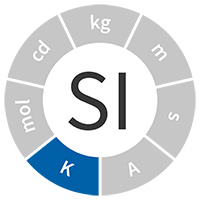- In buildings, accurate temperature measurements ensure efficient use of energy and human comfort.
- In the food industry, accurate temperature measurements are critical to product quality and safety.
- In manufacturing, accurate temperature measurements are essential for minimising costs and ensuring quality and minimising waste.
- In precision engineering, temperature affects the size of every component, and so the uncertainty in the size of an object is limited by the uncertainty with which its temperature is known.
 Accurate temperature measurements are important in every field of human endeavour.
Accurate temperature measurements are important in every field of human endeavour.
NPL ensures that UK science and engineering can measure temperatures with low uncertainty, thus helping to ensure product quality and reliability.
The kelvin is the SI unit of thermodynamic temperature, and one of the seven SI base units. Unusually in the SI, we also define another unit of temperature, called the degree Celsius (°C). Temperature in degrees Celsius is obtained by subtracting 273.15 from the numerical value of the temperature expressed in kelvin.
Prior to May 2019, all temperatures were defined relative to the triple point of water, the temperature at which water can exist as a solid (ice), a liquid and a gas (water vapour). The temperature at which this condition occurs was defined to be 273.16 K exactly, and every temperature measurement was fundamentally a measure of how much hotter or colder something was than this standard temperature. Whilst convenient for ambient temperatures, this definition increased the uncertainty of measurements at very high and very low temperatures.
Since May 2019, the kelvin and degree Celsius have been defined by taking a fixed numerical value of the Boltzmann constant, k or kB. This change in definition acknowledges that temperature is fundamentally a measure of the average energy of molecular motion.
The kelvin is defined by taking the fixed numerical value of the Boltzmann constant kB to be 1.380 649 × 10−23 when expressed in the unit J K−1, which is equal to kg m2s−2 K−1, where the kilogram, metre and second are defined in terms of 𝘩, 𝒸 and ∆ν.
This was a new definition in May 2019.
Experiments that measure the energy of molecular motion directly – called primary thermometers – are complex and difficult. So the international measurement community recommend that thermometers are calibrated using procedures in the International Temperature Scale of 1990 (ITS-90). These procedures enable the economical calibration of practical thermometers with excellent reproducibility.
Temperature is a measure of the average energy of the motion of the atoms within an object. In most practical cases, it is only possible to measure this energy, or the temperature, indirectly usually by measuring other material properties which are known to be temperature dependent in a reproducible way.
Accurate temperature measurements can be achieved by placing a calibrated sensor, whose temperature-dependent material property is well characterised, in contact with the object or material of interest. Once the temperature of the sensor reaches that of the object, the indirect property can be used, via a calibration equation, to mathematically determine the object's temperature. Typical contact sensors are platinum resistance thermometers, thermocouples and thermistors.
Where contact measurements are not possible, other non-contact methods are available. For example, all objects above absolute zero emit electromagnetic radiation from their surfaces. This is primarily in the infrared range and for objects at or below approximately 1000 K (~700 °C) the radiation is not visible to human eyes. The peak wavelength and intensity of the emitted radiation is dependent on the temperature of the object. Non-contact, or radiation, thermometers are designed to detect the intensity of this radiation, and therefore determine the temperature of the object. More recently non-contact detector technology has developed towards creating multi-pixel arrays where many single spot readings are taken simultaneously and presented as pixels in an image. This is known as thermal imaging.
For calibration purposes, it is important to have environments which can be repeatedly set to have a known temperature. For a comparison calibration, a fluid bath or solid block is used. The bath or block is designed to be as uniform in temperature as possible so that the thermometer under test is in the same thermal environment as a reference thermometer, whose calibration is known. The temperature of the bath or block is then determined by the reference thermometer.
For higher accuracy calibration, a set of reference temperature 'fixed points' can be used. Temperature fixed-point cells have extremely reproducible behaviour and typically use either the melting point, freezing point or triple point (where the solid, liquid and vapour coexist) of pure elements. These fixed points have been studied internationally, and the value of the temperature of each agreed and defined in the International Temperature Scale of 1990 (ITS-90). The ITS-90 can be used in the temperature range above 0.65 K and is the agreed temperature scale in use around the world.
NPL has a world-leading team of researchers working on improving existing temperature measurement techniques, and developing new ones, in order to meet ever more demanding technological and industrial challenges. With the expertise that this research brings, we can also help organisations to understand the impact of reliable temperature measurement on their processes, solve their challenging measurement problems and enable innovative improvements in measurement techniques. Find out more about the research that we are doing in this area.